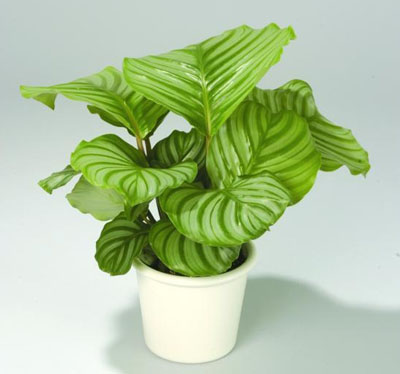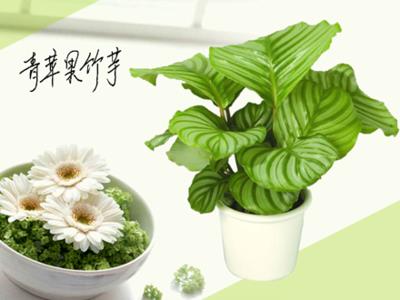How to raise green apple and bamboo taro the propagation method of green apple bamboo taro
Green plant is an indispensable thing in our daily life, which can not only help us do a good job of indoor decoration, but also purify the air. Green apple and taro is very suitable for breeding as a family greening plant. Today, the editor will introduce to you the propagation method of how to raise green apple bamboo taro.

Brief introduction of Green Apple and Bamboo Taro
Green apple bamboo taro is a perennial evergreen herb with leafy roots and clasping leaf sheaths. The plant is relatively tall, usually up to 40 to 70 meters. The petiole is light brownish purple, the leaf blade is round or suborbicular, the ratio of length to width is about 6 ∶ 5, the diameter is usually between 20 cm and 30 mm, the leaf margin is undulate, and the apex is obtusely rounded. The leaf surface is light green or silver gray, the pinnate lateral veins have 6 to 10 pairs of silver gray stripes, the middle rib is also silver gray, and the back of the leaf is light green and light purple. Inflorescences spikelike.
How to raise green apple and bamboo taro
The original species of green apple bamboo taro is produced in Brazil and other countries, and it is selected and cultivated by Europeans from round-leaf taro. It is a very popular indoor foliage plant, suitable for medium-sized potted plants and decorating the house. Sex likes the semi-overcast environment with high temperature and humidity, afraid of cold and avoid strong light. It is appropriate to use acid rotten leaf soil or peat soil which is loose and fertile, well drained and rich in organic matter. The main points of management are as follows:

Moisture: like moist, avoid drought, dry air can easily lead to scorched leaf edge and poor growth. During the growing season, in addition to watering once a day, foliar and environmental spraying should also be strengthened to keep the air relative humidity above 85% to 90%. When the cold winter comes, in addition to paying attention to heat preservation, watering should also be strictly controlled. at this time, when the basin soil is too wet, it is easy to cause root rot, and keep the basin soil slightly dry, even if the leaves wither, the plant will pull out new leaves again after the return of air in spring. When the new leaves begin to germinate, they should not be watered too much. With the increase of new leaves, the amount of water should be increased gradually, which is beneficial to the robust growth of the plant.
Fertilizer: during the growth period, rarefied organic fertilizer can be applied once a week. When potted plants are displayed at home or in public places, 0.2% urea and 0.1% potassium dihydrogen phosphate can be poured or sprayed. After entering summer, when the temperature is higher than 32 ℃, fertilizer should be stopped. In late autumn and early winter, if the temperature in the greenhouse is lower than 18 ℃, all forms of topdressing should be stopped, otherwise it is easy to cause fertilizer damage to rotting roots.
Light: like semi-overcast, avoid strong light exposure. From mid-spring to mid-autumn, shade is required, and the sun is too strong, which can easily lead to pale, dry leaves and even serious burns on the leaves. But the light can not be too weak, otherwise it will cause the leaves to become thinner and dull, losing the fresh beauty they should have. Therefore, potted plants placed in the greenhouse in winter should be given supplementary light.

Temperature: like warm and peaceful environment, not resistant to extreme heat, fear of high temperature, and poor cold resistance, the suitable temperature for its growth is 18 ℃ to 30 ℃. When the ambient temperature exceeds 25 ℃ in late spring and early summer, it is necessary to create a cool, ventilated, moist and semi-overcast environment by setting up a shed to shade and spraying water. In winter, the ambient temperature is required to be no less than 10 ℃. When the temperature in the greenhouse is lower than 5 ℃, the aboveground parts will suffer serious freezing damage. In general, when the ambient temperature drops to 10 ℃ at the end of autumn, it should be moved into the sunny part of the shed in time.
Diseases: the common diseases are leaf spot and scab, which can be sprayed with 0.5 ∶ 0.5 ∶ 100 Bordeaux solution or 50% carbendazim wettable powder, once every 10 days, 2 to 3 times continuously, and a good control effect can be obtained. Insect pests: under high temperature and dry conditions, leaves will appear a large number of small yellow spots due to the harm of red spiders, which seriously reduce its ornamental value. 2000 times of Baileba wettable powder can be sprayed and killed. Sometimes the harm of scale insects occurs.

Reproduction: can be combined with changing pots to split, pay attention to make each split with more leaves and strong roots, new plant planting should not be too deep, all the roots can be buried in the soil, otherwise the growth of new buds will be affected. New plants should control soil moisture, but can often spray water to the leaves to increase air humidity. Wait for new roots to grow before fully watering.
Other precautions: Apple and bamboo taro ventilation, need to be carried out in the external temperature above 16 ℃, can be blown directly on the plant, but when the wind should reduce ventilation or not ventilation, to prevent leaf damage. Less than 16 ℃ is not suitable for more ventilation, which is not conducive to its growth, and gentle wind can also be used to improve air quality. Ventilation is needed both at night and during the day, only in autumn during the day, and reduced or not ventilated at night because of low temperature, mainly to protect bamboo taro.
Propagation method of Green Apple Bamboo Taro
It can be combined with changing pots to split, pay attention to make each split with more leaves and strong roots, the new plant should not be too deep, all the roots can be buried in the soil, otherwise the growth of new buds will be affected. New plants should control soil moisture, but can often spray water to the leaves to increase air humidity. Wait for new roots to grow before fully watering.

The above content is the editor's introduction to the propagation method of how to raise green apple bamboo taro. I believe you can have a better understanding of green apple bamboo taro after reading it. I hope it can help you.
Prevent the leaves from being damaged. Less than 16 ℃ is not suitable for more ventilation, which is not conducive to its growth, and gentle wind can also be used to improve air quality. Ventilation is needed both at night and during the day, only in autumn during the day, and reduced or not ventilated at night because of low temperature, mainly to protect bamboo taro.
Propagation method of Green Apple Bamboo Taro
It can be combined with changing pots to split, pay attention to make each split with more leaves and strong roots, the new plant should not be too deep, all the roots can be buried in the soil, otherwise the growth of new buds will be affected. New plants should control soil moisture, but can often spray water to the leaves to increase air humidity. Wait for new roots to grow before fully watering.

The above content is the editor's introduction to the propagation method of how to raise green apple bamboo taro. I believe you can have a better understanding of green apple bamboo taro after reading it. I hope it can help you.
Related
- Wuhan Hospital Iron Tree Blooming Result Was Instantly Frightened by the Gardener Master
- Which variety of camellia is the most fragrant and best? Which one do you like best?
- What is the small blue coat, the breeding methods and matters needing attention of the succulent plant
- Dormancy time and maintenance management of succulent plants during dormancy
- Minas succulent how to raise, Minas succulent plant pictures
- What are the varieties of winter succulent plants
- How to raise succulent plants in twelve rolls? let's take a look at some experience of breeding twelve rolls.
- Attention should be paid to water control for succulent plants during dormant period (winter and summer)
- Watering experience of twelve rolls of succulent plants
- Techniques for fertilizing succulent plants. An article will let you know how to fertilize succulent plants.



